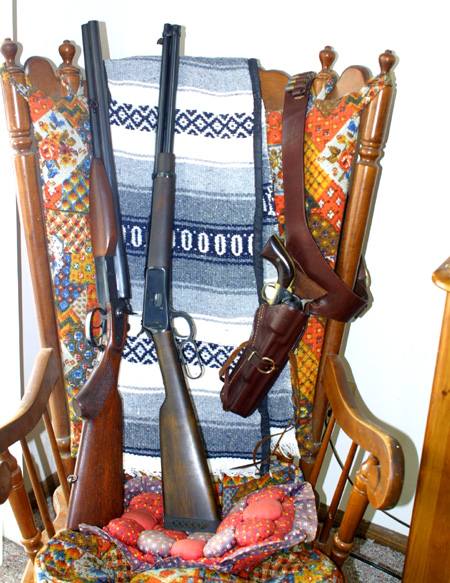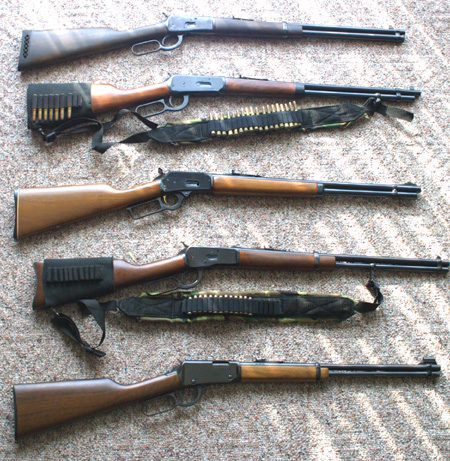Some thoughts on the lever action rifle
 I love lever action rifles. I love them to the extent
that I currently own five, and plan on purchasing at least one more. There
are a number of reasons for this, not the least of which is the cowboy mystique
which is a part of the child hood of every American boy (and a goodly number
of girls too, I suspect). These guns tamed the West, put food in the pot,
protected the family from outlaws, and Indians (in many cases, they protected
Indians from outlaws, and soldiers), and served as a man's trusted companion.
They were tools, and prized possessions, as well as weapons, and to most of
those who owned them, they were the high tech item of the day. Compared to
the converted muskets, and single shot metallic cartridge rifles they had
recently replaced, the new guns were a revelation. They were, on top of everything
else, light and handy. Most of them fired a cartridge, like the venerable
44-40, that could also be chambered in a pistol, and so the great tradition
of the versatile pistol/carbine combination was begun. Back in the old west,
a lever gun was just the thing for rapid fire at distance. When things got
up close and personal, there was always the trusty double barrel shotgun,
and for those everyday contingencies, a man's companion was his dependable
single action 45. A man armed with this trio was about as prepared as he
could be for any situation.
I love lever action rifles. I love them to the extent
that I currently own five, and plan on purchasing at least one more. There
are a number of reasons for this, not the least of which is the cowboy mystique
which is a part of the child hood of every American boy (and a goodly number
of girls too, I suspect). These guns tamed the West, put food in the pot,
protected the family from outlaws, and Indians (in many cases, they protected
Indians from outlaws, and soldiers), and served as a man's trusted companion.
They were tools, and prized possessions, as well as weapons, and to most of
those who owned them, they were the high tech item of the day. Compared to
the converted muskets, and single shot metallic cartridge rifles they had
recently replaced, the new guns were a revelation. They were, on top of everything
else, light and handy. Most of them fired a cartridge, like the venerable
44-40, that could also be chambered in a pistol, and so the great tradition
of the versatile pistol/carbine combination was begun. Back in the old west,
a lever gun was just the thing for rapid fire at distance. When things got
up close and personal, there was always the trusty double barrel shotgun,
and for those everyday contingencies, a man's companion was his dependable
single action 45. A man armed with this trio was about as prepared as he
could be for any situation. The classic lever gun is a sliding breech, locked action, center fire rifle with a tubular magazine, and an exposed hammer which is cocked by the overriding bolt as the lever is cycled. The tubular magazine, which sits beneath the barrel, is loaded through a loading gate on the right side of the receiver. The classic guns eject spent shell casings directly up out of the top, though some latter models were designed to eject to the right, allowing for a scope to be mounted.
Interestingly enough, this most American of all rifles was never adopted by the U.S. Army. During the Civil War, the North purchased a form of repeating arm in the Spencer, and Henry rifles, but the Henry was a large, heavy gun which fired a poorly designed .44 rimfire cartridge, and the Spencer had an outside hammer which had to be cocked separately after the action was worked; it also contained it's tubular magazine within the stock. Neither of the guns were used in large numbers; they were used only as war time expedients and were never officially adopted. Both were dropped after the war in favor of the single shot Springfield rifle. The single shot, trapdoor Springfield was to remain the official arm of the U.S. military until 1892, by which time the strength and accuracy of the new bolt action rifle was to totally outclass the dated lever guns.
The first lever action to bear the Winchester name was the model 1866, which was essentially an improved version of the old Henry rifle. The 66, like the Henry, fired a rimfire cartridge at what would today be considered low pressures, and velocities. The gun held fifteen rounds, and was often nick named the Yellow Boy, in reference to it's brass (actually bronze) receiver. The famous Winchester lever action of The Old West, was largely the model 73.
The Winchester Model of 1873 was made in huge numbers, and was a fixture of the western United States. It was chambered for a series of centerfire cartridges, most notably the 44-40. Like many legendary items, the 1873 owes its status to its superiority over contemporary designs, and its time and place of introduction. The year 1873 was in the midst of Western expansion, the height of the Indian wars. This was, much mre so than the Colt Peacemaker, the gun that won the west. The 1894 model introduced bottleneck cartridges to the civilian shooter. At its introduction, the 30-30 cartridge was an amazing round. It had a flatter trajectory, more range, and more energy than just about anything else out there, and it was chambered in a relatively small and light carbine.
Light, handy, quick firing, with a large (for the time) magazine, lever actions were the assault rifles of their day, even in the use of a less than full powered cartridge. Back when the average rifle weighed between nine and fifteen pounds, and fired a single shot, the lever action guns came in at about six pounds (about the same as an M-16), and could hold as many as a dozen cartridges. Even today the little guns have much to recommend them. They are simple and robust in design. They are not fussy about ammunition, as most semi autos are. They are still as light and handy as ever, and they are inexpensive. The traditional designs are chambered in a number of popular pistol calibers, which makes them a natural companion for a handgun. Ballisticly,
 the classic lever cartridges (like the 30-30), are very similar to the .223,
and 7.63x39 cartridges used in the M-16, and AK-47 assault rifles. The .223
cartridge is slightly flatter shooting, but the 7.63 is almost identical in
energy and trajectory to the old 30-30.
the classic lever cartridges (like the 30-30), are very similar to the .223,
and 7.63x39 cartridges used in the M-16, and AK-47 assault rifles. The .223
cartridge is slightly flatter shooting, but the 7.63 is almost identical in
energy and trajectory to the old 30-30. This was a very high tech, precision, expensive article, back a century or so ago. It also introduced a number of firsts, to military and civilian shooters alike. These were the first really widespread, refined repeaters (I know about the Henry, and the Spencer but these two models just don't compare). The lever action, as it is known today, was first embodied in the model 66, made famous in the model 73, and completely refined in models 92, and 94. (there was also a model 95, and lever actions by Browning, and Savage, but these were quite different in design, using box magazines, and a rotating bolt) In addition to introducing the repeating firearm to the public at large, these were also the first widespread production guns to use bottle necked cartridges, and the first to use smokeless powder. For roughly thirty years, until development of the bolt action, the lever action was the only real option in repeating firearms.
Though very much on the cutting edge of their own time, the lever guns also foreshadowed, and assisted the development of most of today's small arms. While the lever gun was outclassed by the bolt action's virtues of strength, and durability, the bolt guns played little part in the continuing advance of firearms design, remaining much the same today as they were at their introduction. The lever action story is quite different. The design of most modern repeating arms can be traced back to experimentation's with lever action guns. In particular, John M Browning developed both a recoil, and a gas operated semi auto directly from the lever action. The first of these contraption guns were ungainly, fragile, temperamental, and totally impractical, but they did demonstrate the viability of the concepts, and showed Browning the way to go.
The initial gas operated gun had what amounted to a small sail or wind catcher on the end of the barrel. Browning got the idea because he had noted that firing a rifle near the ground caused dust to rise. He correctly attributed this to the force of propellant gasses escaping from the muzzle. If these gasses can move dust around, thought Browning, then why can't they be used to move the loading mechanism of a rifle? A thin metal blast shield was placed on a hinge, just below the muzzle. It was mounted on a pivot, and connected to a long rod beneath the barrel. This rod was connected to a small trip lever which actuated the lever mechanism of the rifle. When the rifle was fired, the muzzle blast forced the blast shield down and worked the lever. A spring was used to return the lever to it's original position and complete the cycling of the action. The action was so ungainly, heavy, and delicate, that Browning soon hit upon the idea of using a port (hole) in the barrel to bleed gasses off, rather than trying to harness them after they had left the barrel. His first machine gun design, nicknamed the potato digger, actually did have a lever underneath, which covered a gas port. Upon firing, gasses exiting the port would blow the lever down, and cycle the action. The design was latter modified to use a piston, because the lever prevented the guns from being mounted too low to the ground. These guns were used in teh First World War.
Classic styled lever actions are commonly found in scabbards gracing the sides of horses, Jeeps, Motorcycles, SUVs, and the occasional airplane. They have found a renewed popularity in the modern pass time of cowboy action shooting, and still retain a popularity with certain segments of the hunting, ranching, and outdoor communities that they have always had. There has been a trend, in the last thirty years of so, to chamber classic lever actions in a variety of magnum revolver cartridges, making them a natural companion for the revolver enthusiast, woodsman, or frugal recreational shooter. These pistol chambered lever actions are cheap to shoot, cheap to buy, and quite capable.
Western hunters generally go with high powered bolt action guns, but in the forests and brush of the East, and Middle West, the lever action is still the traditional hunters tool. The guns are light and small enough to be lugged through the woods without too much trouble, and at the close ranges within which most shots are taken, the intermediate cartridges are plenty powerful enough. I currently own a classic Winchester 94 a Marlin 1892 a Rossi 92s a Rossi Puma in 454, and a Henry 22. After over a hundred years of history, the gun that was never adopted by the U.S. Army, still serves.
